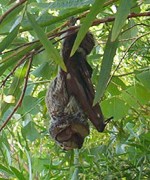The 30 middle school students from Valley View's after school Science Club anxiously file off the bus at Rio Salado, Phoenix's recently restored riparian habitat. Two Phoenix park rangers are waiting to meet the children before they walk through the park, but getting them to quiet down to listen to the rangers is a challenging task. Aged between eight and 11 years, the children are quick to ask questions and, as the rangers pass out binoculars for them to use, they begin to ask about what they might see in the park. The rangers patiently answer their questions and remind them of the park rules, such as staying on the trails so they don't damage the plant life, and picking up trash after them and putting it in the trash bins that the science club from the previous year painted and donated as their community project. Once their curiosities are satisfied, the children are ready to get started on the park trail.
Students from Valley View Elementary’s after school Science Club on as part of CAP LTER’s Service at Salado program. Service at Salado has introduced science and technology as viable career options to a host of middle-school students and shown them the impact of community service. Photo: Nazune Menka
As the group makes its way toward the water, a student up ahead yells for the others to hurry up: “It’s a bat!” With that declaration, the rest of the students scramble up the trail to catch up. And sure enough, hanging upside down on the branch of a small tree apparently taking a late afternoon nap is a bat.
The students crowd around the bat to get as close as possible and begin to take pictures with digital cameras loaned to them by the Service at Salado program, CAP LTER’s schoolyard program based at Arizona State University. They stare in awe at this little creature they have previously only seen on television. We are literally inches from the bat and inching closer by the second. Suddenly, one of the students makes a startling noise and the bat’s wings fly open. Screams and yells rend the air as we all jump back a foot or two. Thankfully, it seems we haven’t disturbed our new friend too much because the bat closes it’s wings again and appears to go back to sleep. We decide to back off and continue with our tour of the park hoping to encounter other mini adventures but, ultimately, the bat proves to be the most exciting moment for our group’s first visit to Rio Salado.
This first visit allowed the students to see and experience a restored habitat right in the middle of their community, thus setting the foundation for helping them understand the importance of environmental advocacy, habitat restoration, and water conservation. The Service at Salado program allows four middle schools to hold science clubs, take two trips to Rio Salado, and create a community service project that the students get to showcase at the end of semester celebrations at Phoenix’s South Mountain Environmental Education Center.
The park, comprising a five mile stretch of restored habitat, is fairly new to Phoenix, and to the studentsof Valley View, the program’s focus on hands-on, community service oriented learning techniques and associated park visits provides a welcome break from regular classroom learning. The Valley View club is currently creating video public service announcements and environmental education videos that the City of Phoenix can use to publicize Rio Salado. Their videos will also be entered in a digital video contest about Arizona water that is being organized by Arizona State University. The deadline for submissions is March 2007, but the Valley View team intends to submit its entry in early December. Wish us luck!

 Enlarge this image
Enlarge this image
